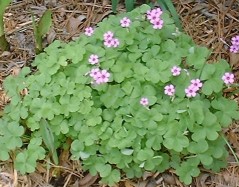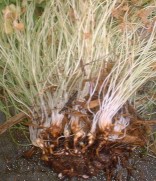 Nice,
neat mounds. Pretty pink/purple, white, or yellow flowers.
Medicinal properties, and the flowers, bulbs, and leaves are edible and
taste good too! Who wouldn't go for Oxalis, otherwise named Wood Sorrell......
Nice,
neat mounds. Pretty pink/purple, white, or yellow flowers.
Medicinal properties, and the flowers, bulbs, and leaves are edible and
taste good too! Who wouldn't go for Oxalis, otherwise named Wood Sorrell......
ME ME ME ME ME!!!
I don't give derogatory personal opinions on specific plant materials too
much on this site, but I have definite opinions on this cute little beast
from hell. I don't care if it cures cancer - it is an invasive, nasty
little creature that I will have to live with and that future owners of
my house will have to live with until a nuclear explosion wipes humanity
out. Never fear though, the Oxalis will survive.
But I digress - my job is to profile this miserable little entity in the
gardening and herb world, and I will diligently do that. Note that
on the links to the left, I have added an unusual extra link specifically
dealing with eradication of this wretched little nightmare, including what
I have personally learned in my own remarkably unsuccessful quest to rid
my garden of it.
Alrighty then, to be fair, there are Oxalis specimens that are not totally
invasive, but be afraid......be very afraid....and thoroughly do your homework
when contemplating adding this plant to your home landscaping scheme.
As noted above, Oxalis is a pretty little plant, often called Sourgrass
or Wood Sorrel. The leaves are clover-shaped and the flowers are borne
above the neat mounds of foliage. Flowers are pinkish-purple, yellow,
or white. When it is cloudy or rainy or nighttime, the flowers all
close and the leaves fold over to conserve moisture. Some non-invasive varieties
have beautiful purple or purple-pink foliage in interesting shapes.
Oxalis leaves are edible and have a pleasant kind of tart-sour lemon taste.
Oxalis contains Oxalic Acid, so should be eaten in moderation - more on
that in the medicinal section of Oxalis linked at top left.
Non-invasive Oxalis types include:
Iron Cross - Oxalis Triangularis
Purple Shamrock - Oxalis Regnellii
Silver & Gold - Oxalis Braziliensis
Invasive Oxalis types include:
Redwood Sorrel - Oxalis Oregona
Violet Wood Sorrel - Oxalis Violacea
White, Pink, or Yellow Wood Sorrel - Oxalis Crassipes
 Oxalis
is a bulb, and an energetic bulb at that. Invasive types quickly create
offset bulbs for more plants, and also send out lateral runners, thus spreading
rapidly in all directions. Though the plants produce seed, the seed
has never been proven to be viable, and thus nobody really knows how the
plant overtakes so much terrain so quickly, jumping across roads, over rivers,
and into containers and window boxes on tall structures with apparent ease.
Bulbs form a dense mat underground, choking out the roots of other plants.
Foliage and flowers form dense clumps above ground, robbing lower growing
plants of space and light, in addition to the the root competition.
Lateral runners travel fast and look similar to white icicles. The
picture to the right is a clump I pulled up showing brown bulbs on the bottom,
then white runners, and then stems and leaves. Oxalis will give even other
aggressive plants a real run for their money, and will quickly and successfully
muscle out many landscape plants, some much bigger than the Oxalis itself.
Oxalis
is a bulb, and an energetic bulb at that. Invasive types quickly create
offset bulbs for more plants, and also send out lateral runners, thus spreading
rapidly in all directions. Though the plants produce seed, the seed
has never been proven to be viable, and thus nobody really knows how the
plant overtakes so much terrain so quickly, jumping across roads, over rivers,
and into containers and window boxes on tall structures with apparent ease.
Bulbs form a dense mat underground, choking out the roots of other plants.
Foliage and flowers form dense clumps above ground, robbing lower growing
plants of space and light, in addition to the the root competition.
Lateral runners travel fast and look similar to white icicles. The
picture to the right is a clump I pulled up showing brown bulbs on the bottom,
then white runners, and then stems and leaves. Oxalis will give even other
aggressive plants a real run for their money, and will quickly and successfully
muscle out many landscape plants, some much bigger than the Oxalis itself.
Non-aggressive types of Oxalis make wonderful houseplants, container plants,
and bedding plants, with interesting foliage, pretty flowers, and long bloom
times. The more aggressive types would also make great container plants,
but since we don't know for sure how they jump from one place to another,
growing them in containers in the home garden would be a needlessly risky
endeavor, in my opinion. Propagation for all types of Oxalis is done
by digging the bulbs and separating the offshoots, best done in early spring.
Lastly,
Oxalis is a common greenhouse pest, so check any potted plants you buy and
if you see little green clover-shaped leaves in the pot, make sure you get
rid of them roots and all before planting in the garden, or you will have
created a problem that could take years to fix.
Other links related to Oxalis are provided at the top left, so if something
you need has not been covered on this page, please choose a link and read
on for further information.
 Nice,
neat mounds. Pretty pink/purple, white, or yellow flowers.
Medicinal properties, and the flowers, bulbs, and leaves are edible and
taste good too! Who wouldn't go for Oxalis, otherwise named Wood Sorrell......
Nice,
neat mounds. Pretty pink/purple, white, or yellow flowers.
Medicinal properties, and the flowers, bulbs, and leaves are edible and
taste good too! Who wouldn't go for Oxalis, otherwise named Wood Sorrell...... Oxalis
is a bulb, and an energetic bulb at that. Invasive types quickly create
offset bulbs for more plants, and also send out lateral runners, thus spreading
rapidly in all directions. Though the plants produce seed, the seed
has never been proven to be viable, and thus nobody really knows how the
plant overtakes so much terrain so quickly, jumping across roads, over rivers,
and into containers and window boxes on tall structures with apparent ease.
Bulbs form a dense mat underground, choking out the roots of other plants.
Foliage and flowers form dense clumps above ground, robbing lower growing
plants of space and light, in addition to the the root competition.
Lateral runners travel fast and look similar to white icicles. The
picture to the right is a clump I pulled up showing brown bulbs on the bottom,
then white runners, and then stems and leaves. Oxalis will give even other
aggressive plants a real run for their money, and will quickly and successfully
muscle out many landscape plants, some much bigger than the Oxalis itself.
Oxalis
is a bulb, and an energetic bulb at that. Invasive types quickly create
offset bulbs for more plants, and also send out lateral runners, thus spreading
rapidly in all directions. Though the plants produce seed, the seed
has never been proven to be viable, and thus nobody really knows how the
plant overtakes so much terrain so quickly, jumping across roads, over rivers,
and into containers and window boxes on tall structures with apparent ease.
Bulbs form a dense mat underground, choking out the roots of other plants.
Foliage and flowers form dense clumps above ground, robbing lower growing
plants of space and light, in addition to the the root competition.
Lateral runners travel fast and look similar to white icicles. The
picture to the right is a clump I pulled up showing brown bulbs on the bottom,
then white runners, and then stems and leaves. Oxalis will give even other
aggressive plants a real run for their money, and will quickly and successfully
muscle out many landscape plants, some much bigger than the Oxalis itself.